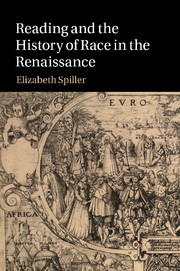Book contents
- Frontmatter
- Contents
- Acknowledgements
- Introduction: Print Culture, the Humoral Reader, and the Racialized Body
- 1 Genealogy and race after the Fall of Constantinople: From The King of Tars to Tirant lo Blanc and Amadis of Gaul
- 2 The form and matter of race: Aethiopika, hylomorphism, and neo-Aristotelian readers
- 3 The conversion of the reader: Ariosto, Herberay, Munday, and Cervantes
- 4 Pamphilia's black humor: reading and racial melancholy in the Urania
- Notes
- Index
Introduction: Print Culture, the Humoral Reader, and the Racialized Body
Published online by Cambridge University Press: 01 June 2011
- Frontmatter
- Contents
- Acknowledgements
- Introduction: Print Culture, the Humoral Reader, and the Racialized Body
- 1 Genealogy and race after the Fall of Constantinople: From The King of Tars to Tirant lo Blanc and Amadis of Gaul
- 2 The form and matter of race: Aethiopika, hylomorphism, and neo-Aristotelian readers
- 3 The conversion of the reader: Ariosto, Herberay, Munday, and Cervantes
- 4 Pamphilia's black humor: reading and racial melancholy in the Urania
- Notes
- Index
Summary
He that goeth in the Sonne, shalbe Sonne burnt, although he thinke not of it. So they that will read this, or such like Bookes, shall in the ende, bee as the Bookes are.
Thomas Wilson, The Arte of Rhetorique (1560)Oft turning others' leaves, to see if thence would flow
Some fresh and fruitful showers upon my sunburnt brain.
Philip Sidney, “Astrophil and Stella” (c. 1581)This is a book about early modern book history and race. Thus far, book history and critical race studies have been two very different scholarly activities. Scholarship in the history of the book has given us a rich account of the materiality of early modern texts. The concept of the “sociology of the text” has encouraged us to follow the material life-cycle of texts through the process that began with the making of ink and paper and ended with the printing, sale, and binding of volumes that readers then annotated with their own pens and ink, often beginning a new process of production and consumption. While this approach has produced an exciting and influential body of scholarship, book history has had less to say about the history of human identity that such texts record and create. In particular, book history has not focused on cultural categories such as race primarily because scholarship has assumed a divide between the form of books (their material state, which is part of book history) and their content (which is generally not).
- Type
- Chapter
- Information
- Reading and the History of Race in the Renaissance , pp. 1 - 40Publisher: Cambridge University PressPrint publication year: 2011



